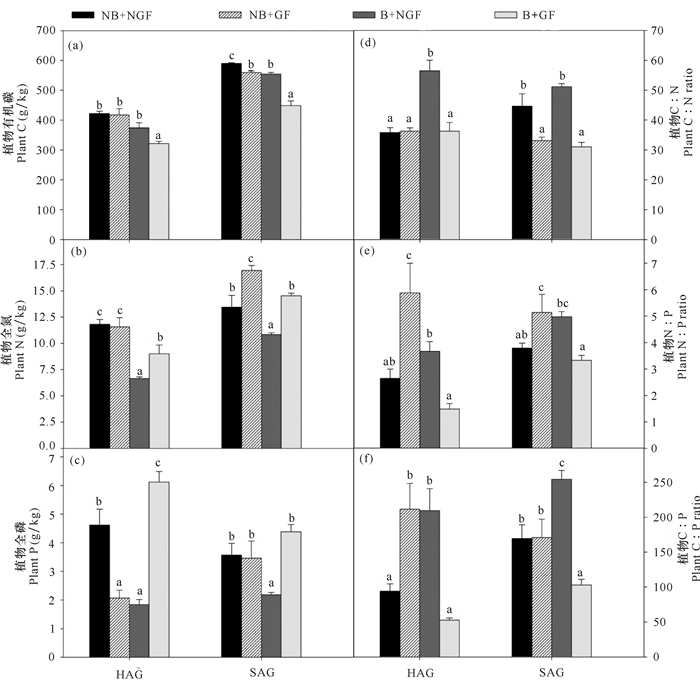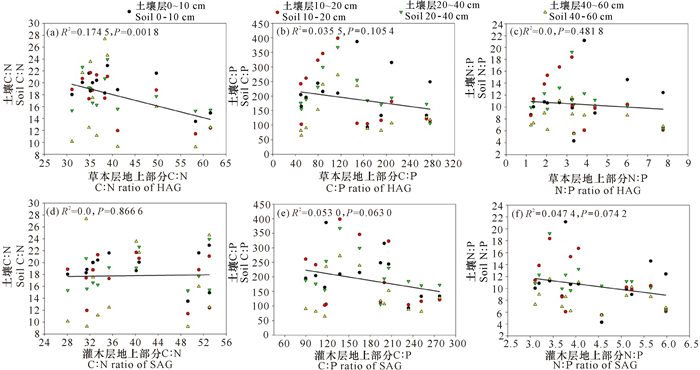2. 广西大学林学院,广西高校林业科学与工程重点实验室,广西南宁 530004;
3. 广西友谊关森林生态系统定位观测研究站,广西凭祥 532600;
4. 中国林业科学研究院热带林业实验中心,广西凭祥 532600
2. Guangxi Colleges and Universities Key Laboratory of Forestry Science and Engineering, Forestry College, Guangxi University, Nanning, Guangxi, 530004, China;
3. Guangxi Youyiguang Forest Ecosystem Research Station, Pingxiang, Guangxi, 532600, China;
4. Experimental Center of Tropical Forestry, Chinese Academy of Forestry, Pingxiang, Guangxi, 532600, China
【研究意义】桉树是世界公认的三大速生树种之一,被全球热带亚热带地区广泛种植。随着全球环境意识的不断增强,桉树人工林的营林理论和技术遭到严峻挑战,探讨桉树人工林绿色可持续营林理论和技术具有全球意义。【前人研究进展】炼山是我国南方林区清理林地的传统方法。有研究表明,炼山有利于林地的清理、整地和造林工作,同时也有利于改善采伐迹地的卫生状况,降低造林抚育成本[1-4]。炼山还可消除一些非目标物种,为幼林的生长扫除竞争,还能够促进腐殖质形成和养分归还,有利于人工林的早期生长[5]。但炼山容易造成水土流失、大气污染、破坏生物多样性及引发森林火灾等[4]。炼山能够短时间提高土壤肥力、造林成活率及林下植被发育,但会降低生物多样性、加重水土流失[6-9]。近年来,套种绿肥也是人工林经营中较常用的培肥措施,即在林分中种植1年生或多年生绿肥植物作为覆盖林地的一种土壤管理方法。大量研究表明,套种绿肥可以增加生物量,改善土壤结构, 提高土壤肥力[10];绿肥在提高土壤有机质含量的同时, 可增加土壤碱解氮、速效磷和速效钾含量[11-13], 使土壤容重下降、孔隙度和水稳性结构体增加[14];绿肥在提高土壤肥力的同时[15-16], 还能减少和阻止土壤侵蚀,保持土壤质量,对退化地的改良具有很好的效果[17]。【本研究切入点】生态化学计量学是生物地球化学研究的重要内容, 主要研究植物各器官和土壤C、N、P养分含量及计量比值变化, 有助于揭示植物生长的养分分配和限制因子状况, 以及植物与土壤的作用关系[18-19]。本研究探讨炼山、套种绿肥等营林措施对桉树人工林林下植物和土壤生态化学计量特征的影响。【拟解决的关键问题】通过炼山和套种绿肥等营林措施的比较试验研究,定量分析不同营林措施对桉树人工林生态化学计量特征的影响,为桉树人工林绿色可持续发展提供理论依据。
1 样地设置与研究方法 1.1 样地设置及概况样地位于广西凭祥市热带林业实验中心青山实验场67林班(22°10′N,106°41′E),海拔200~300 m,属于干湿季分明的南亚热带季风气候。土壤为砖红壤,pH值为4.1~6.0。试验地前茬为1975年营造的马尾松纯林。2011年11月皆伐、整地后于2012年春以“双龙出海”模式种植桉树,造林密度为1 428株/hm2。本实验采用随机区组实验设计,每区组重复3次,各区组均设置4个面积为30 m×20 m的样方,随机布设不炼山+不套种绿肥(CK)和炼山+不套种绿肥(B+NGF)、不炼山+套种绿肥(NB+GF)、炼山+套种绿肥(B+GF)4种处理。在桉树宽行(7 m)间套种绿肥(山毛豆),种植绿肥的行距为50 cm。各样地的基本情况见表 1。
| 表 1 样地的基本情况 Table 1 Basal situation of the sampling plots |
将每个30 m×20 m样方随机设置3个5 m×5 m、2 m×2 m的小样方,分别用于采集灌木层、草本层植物地上部分样品,分装入牛皮纸信封,带回实验室烘干。
1.2.2 土壤样品的采集在每个30 m×20 m样地按品字形挖3个土壤剖面,按照0~10 cm、10~20 cm、20~40 cm、40~60 cm分层采集土壤样品,各层土壤混匀后制成混合土样,自然风干用于测定土壤有机碳、全氮、全磷。
1.3 样品的分析测定将烘干的植物样品和风干的土样分别研磨后,过100目筛。分别准确称取0.5 g植物、土壤样品,采用重铬酸钾氧化-外加热法测定植物、土壤有机碳含量[20]。分别准确称取0.5 g植物、土壤样品,经硫酸铜-硫酸钾-硫酸消煮(5 mL浓硫酸及1.0 g CuSO4、10.0 g K2SO4混合催化剂)浸提后,采用AA3型连续流动化学分析仪(德国Bran Luebbe)测定全氮含量[21]。分别准确称取0.5 g植物、土壤样品,采用酸溶-钼锑抗比色法测定全磷含量[22-23]。
1.4 数据处理采用单因素方差分析(one-way analyses of variance)检验不同处理植物、土壤C、N、P化学计量学特征的差异(P < 0.05),采用回归分析探讨植物与土壤C:N:P之间的关系。统计分析在SPSS 19.0软件完成,采用Sigmaplot 10.0作图,所有数据均以均值±标准误表示。
2 结果与分析 2.1 炼山和套种绿肥对桉树人工林林下植物C、N、P的影响由图 1a~c可以看出,炼山、套种绿肥对桉树人工林下植物地上部分有机C、N、P含量有显著的影响。不炼山+不套种绿肥处理的草本、灌木层植物地上部分有机碳含量最高,分别为422.27 g/kg和590.37 g/kg,炼山+套种绿肥处理的最低,相应为321.65 g/kg和449.08 g/kg,炼山+套种绿肥处理显著降低草本、灌木层植物的有机碳含量(P < 0.05);炼山+不套种绿肥处理和不炼山+套种绿肥处理的居二者之间,但其有机碳含量也显著高于炼山+套种绿肥处理(图 1a)。

|
HAG:草本层地上部分;SAG:灌木层地上部分;NB+NGF:不炼山+不套种绿肥;NB+GF:不炼山+套种绿肥;B+NGF:炼山+不套种绿肥;B+GF:炼山+套种绿肥;不同小写字母表示不同处理下各组分之间的C、N、P化学计量之间存在显著差异 HAG:Aboveground part of herb layers; SAG:Aboveground part of shrub layers; NB+NGF:Without controlled burning and green manure plant interplanting; NB+GF:Without controlled burning but interplanting green manure plant; B+NGF:Controlled burning without green manure plant interplanting; B+GF:Controlled burning and green manure plant interplanting.Different lowercase indicates significant difference between C, N, P stoichiometry under different treatments 图 1 炼山及套种绿肥对林下植物C、N、P影响 Fig.1 Effects of controlled burning and green manure plant interplanting on understory C, N and P |
不同处理草本和灌木层植物地上部分全氮含量变化分别为6.64~11.82 g/kg、10.84~16.95 g/kg。不炼山条件下,草本植物地上部分全氮含量显著高于炼山处理。灌木层植物地上部分全氮含量表现为套种绿肥显著高于不套种绿肥(P < 0.05, 图 1b)。
与不炼山+不套种绿肥处理相比,炼山+套种绿肥处理能显著提高草本层地上部分全磷含量(6.12 g/kg),而不炼山+套种绿肥处理、炼山+不套种绿肥处理则显著降低草本层地上部分全磷含量(图 1c)。炼山+套种绿肥处理也能提高灌木层植物地上部分全磷含量(4.39 g/kg),但与不炼山+不套种绿肥和不炼山+套种绿肥处理的差异不显著,而炼山+不套种绿肥处理灌木层地上部分全磷含量最低(2.19 g/kg),显著低于其他处理。
炼山+不套种绿肥处理草本层地上部分C:N(56.51)及C:P(209.31)显著高于不炼山+不套种绿肥,而不炼山+套种绿肥的N:P(5.88)及C:P(211.43)显著高于不炼山+不套种绿肥(图 1d、e、f)。而灌木层地上部分C:N表现为不套种绿肥的显著高于套种绿肥的。不炼山+套种绿肥处理灌木层地上部分N:P(5.13)显著高于不炼山+不套种绿肥(3.79)和炼山+套种绿肥处理(3.33),但与炼山+不套种绿肥的差异不显著(图 1e)。炼山+不套种绿肥处理灌木层C:P(254.26)最高,显著高于不炼山处理的,而炼山+套种绿肥的最低(103.20),显著低于其他处理(图 1f)。
2.2 炼山和套种绿肥对桉树人工林土壤C、N、P的影响从图 2可以看出,土壤有机碳和全氮含量随土壤层次的加深而递减,土壤表层有机碳和全氮含量最高,分别为(29.76±1.16)g/kg和(1.58±0.06)g/kg;土壤全磷在表层土0~10 cm富集最多(0.15±0.016)g/kg,呈现随土壤深度先减小后增加的趋势。从图 2a中可以看出,不管炼山还是套种绿肥都降低20~40 cm、40~60 cm土层的有机碳含量;对于0~10 cm、10~20 cm土层,单一的炼山或套种绿肥都降低有机碳含量,而炼山+套种绿肥反而显著提高有机碳含量,但都比不炼山+不套种绿肥处理的有机碳含量低。炼山显著提高20~40 cm土层的全氮含量(P<0.05),套种绿肥对土壤全氮有一定的影响,但差异不显著(P>0.05)(图 2b)。单一的炼山处理提高了土壤的全磷含量,单一的套种绿肥有效提高10~20 cm、20~40 cm、40~60 cm土层的全磷含量,表层土0~10 cm不管是炼山还是套种绿肥都显著降低了土壤中的全磷含量(P<0.05)(图 2c)。

|
NB+NGF:不炼山+不套种绿肥;NB+GF:不炼山+套种绿肥;B+NGF:炼山+不套种绿肥;B+GF:炼山+套种绿肥;不同小写字母表示不同处理下同一土壤层次的C、N、P化学计量之间的差异 NB+NGF:Without controlled burning and green manure plant interplanting; NB+GF:Without controlled burning but interplanting green manure plant; B+NGF:Controlled burning without green manure plant interplanting; B+GF:Controlled burning and green manure plant interplanting; Different lowercase indicates significant difference between soil C, N, P stoichiometry under different treatments 图 2 炼山及套种绿肥对土壤C、N、P的影响 Fig.2 Effects of controlled burning and green manure plant interplanting on soil C, N and P |
从图 2d可以看出,炼山降低了土壤的C:N,尤其是40~60 cm土层(P<0.05),套种绿肥降低了土壤的C:N, 炼山+套种绿肥提高0~10 cm及10~20 cm土层的C:N,却降低20~40 cm及40~60 cm土层的C:N, 但总体差异不显著(P>0.05),对照处理的土壤C:N最高, 且0~10 cm土层的C:N与土壤有机碳含量一致,其他土层的C:N与土壤全氮含量一致。从图 2e中可以看出,不炼山情况下套种绿肥提高表层0~10 cm却降低20~40 cm、40~60 cm土层的N:P, 但差异不显著(P>0.05),显著降低10~20 cm土层的N:P(P<0.05);炼山情况下套种绿肥不同程度的提高土壤的N:P,但差异不显著(P>0.05),土壤的N:P与全磷含量升降趋势相反;不同处理20~40 cm、40~60 cm土层的N:P无显著差异。炼山显著降低土壤的C:P(P<0.05),套种绿肥显著提高0~10 cm的C:P(P<0.05)却降低其他土层的C:P;炼山+套种绿肥处理对土壤的C:P有一定的影响,但含量升降的幅度不大(P>0.05),除了0~10 cm土层C:P与全磷含量一致外,其他土层C:P与C含量升降趋势一致(图 2f)。
2.3 桉树人工林土壤与林下植物生态化学计量特征的相关关系由图 3可知,土壤与林下草本、灌木层植物地上部分的生态化学计量比大都呈现负相关关系,但只有0~10 cm土壤与草上的C:N相关性显著(P<0.05)。

|
图 3 林下植物地上部分与土壤的相关关系 Fig.3 Relationship between the aboveground parts of understory parts and soil |
植物C:N和C:P代表植物吸收营养元素时同化C的能力,反映了植物对营养元素的利用效率[24]。Göran[25]与Stemer等[26]的研究也指出,C:N、C:P越大,植物生长速度越快。在本研究中,林下灌木层、草本层植物的C:N都高于全国平均水平(28.5)[27],说明林下灌木层同化C的能力较强,并能高效利用营养元素,有利于植物的生长。N:P常作为指示植物氮受限或磷受限的指标,N:P值小于14意味着氮受限,而N:P值大于16则意味着植物更多地受到磷的限制,介于两者之间表明受到氮、磷元素的共同限制[28-29]。本实验中,不同处理的N:P(2.04±0.11~4.31±0.28)远远低于全国N:P水平(14.4)[30]和全球平均水平(13.8)[31],这可能与本研究测定的是植物地上部分而非叶片有关。
土壤养分含量是衡量土壤肥沃程度的量化指标,是土壤重要的生态功能,也是植物生长发育的基础。土壤养分状况的好坏直接影响着人工林群落树木生长状况及群落的稳定性,而树木的生长状况又反过来影响土壤的性质和养分状况[32]。本研究中,土壤有机碳和全氮含量随土壤层深度的加大而递减,而土壤全磷呈现随土壤深度先减小后增加的趋势,表层0~10 cm全磷含量最高,这是表层土壤受到外界环境因素和凋落物养分归还的影响,导致养分首先在土壤表层聚集,然后随着水或者其他介质向下迁移扩散,使得土壤表层C、N、P含量一般较深层高。由于土壤磷元素主要来源于母质的矿化,而植物磷元素主要来源于土壤[33],故土壤表层0~10 cm磷元素得到凋落物的归还补偿,中层土壤磷元素被植物吸收而补偿相对较小,使得土壤全磷随土层深度先减小后上升。
土壤C、N、P化学计量比是衡量土壤有机质组成和质量的重要指标,C:N是土壤质量比较敏感的指标,土壤的C:N越低越利于微生物的分解,更加利于N的矿化养分释放[34]。本研究发现,表层土0~10 cm的C:N(19.07±0.78)、C:P(212.02±23.49)最高,40~60 cm土层的最低,但都比全国平均水平(14.4, 136)高[35];对于N:P,土层20~40 cm的最高,40~60 cm的最低。也有研究表明微生物需要C:N约为25:1的底物来满足它们的需氮量,当底物的C:N较高时,微生物需要摄取更多的氮来满足其生长;而C:N较低时,氮超过微生物生长所需的部分就会释放到枯落物和土壤中[36]。本研究中林地C:N小于25:1,则有利于微生物分解释放氮素,40~60 cm土层有利于微生物的分解及N矿化养分的释放。土壤C:P比值可作为衡量微生物矿化土壤有机物质释放磷或从环境中吸收固持磷素潜力的一种指标[37]。有研究表明,C:P比值小(小于全国平均值136)[35]微生物在矿化土壤有机质中释放磷的潜力较大[38],说明研究林分土壤微生物还得从环境中吸收摄取磷素,加剧磷素的竞争。
本研究表明,炼山降低土壤的有机碳含量和土壤0~10 cm的全氮含量,提高10~20 cm、20~40 cm、40~60 cm土层的全氮含量,但提高或降低全氮的幅度不大, 这与黄莉等[7]的研究结果一致。本研究还发现,炼山提高土壤的全磷含量。
本研究中,套种绿肥之后,显著降低0~10 cm的有机碳和全磷含量(P<0.05),小幅度降低0~10 cm、10~20 cm土层的全氮含量(P>0.05),这与刘小粉等[39]的研究结果一致。套种绿肥降低了10~60 cm土层的有机碳却提高了20~60 cm土层全氮含量和10~60 cm土层的全磷含量。对于套种绿肥后的林下植物有机碳含量降低,灌木层植物的全氮、全磷含量提高,以及草本层植物的全磷含量显著降低,其原因可能是:(1)套种绿肥(山毛豆)之后,山毛豆吸收土壤中的有机碳用于自身的生长,土壤有机碳含量降低,且山毛豆与林下植物竞争土壤中有机碳养分,使得林下植物有机碳含量降低。(2)山毛豆有固氮作用,有助于提高土壤氮含量。与此同时,在土壤N限制状态下,豆科植物与非豆科植物相比,对氮具有更强的竞争力,山毛豆吸收土壤表层的氮素用于自身的生长,使得表层土壤草本层植物全氮含量降低。(3)套种绿肥后土壤表层的全磷含量被绿肥吸收而降低,使得浅根系的草本层全磷含量下降。有关研究表明,套种绿肥有助于磷活化及土壤结构的改善[39],所以下层土壤的全磷含量较表层的高。
炼山+套种绿肥处理后,土壤表层0~10 cm有机碳和全氮含量显著提高,林下草本植物地上部分全氮和全磷含量显著增加(P<0.05),与单一的炼山或套种绿肥处理恰好相反,可能是因为炼山与套种绿肥有某种协同作用,可促进土壤有机碳和全氮含量以及林下植物草上全氮、全磷含量的提高,其作用机制尚需进一步研究。
4 结论炼山可提高林下植物生态化学计量比,却降低了土壤生态化学计量比;套种绿肥总体上提高了林下植物的N:P和C:P,降低了林下植物的C:N及土壤生态化学计量比。炼山+套种绿肥显著影响土壤生态化学计量比值,总体降低林下植物的生态化学计量比,尤其是草上及灌上组分(P<0.05)。
| [1] |
杨尚东, 吴俊, 谭宏伟, 等. 红壤区桉树人工林炼山后土壤肥力变化及其生态评价[J]. 生态学报, 2013, 33(24): 7788-7797. YANG S D, WU J, TAN H W, et al. Variation of soil fertility in Eucalyptus robusta plantations after controlled burning in the red soil region and its ecological evaluation[J]. Acta Ecologica Sinica, 2013, 33(24): 7788-7797. |
| [2] |
马祥庆, 杨玉盛, 林开敏, 等. 不同林地清理方式对杉木人工林生态系统的影响[J]. 生态学报, 1997, 17(2): 176-183. MA X Q, YANG Y S, LIN K M, et al. Effect of different ground clearance on Chinese fir plantation ecosystems[J]. Acta Ecologica Sinica, 1997, 17(2): 176-183. |
| [3] |
温远光, 杨柳, 朱宏光, 等. 除草剂对桉树×降香黄檀混交林下植物功能群的影响[J]. 广西科学, 2015, 22(6): 578-585. WEN Y G, YANG L, ZHU H G, et al. Effects of herbicide application on plant functional groups in mixed Eucalyptus×Dalbergia odorifera plantations in subtropical China[J]. Guangxi Sciences, 2015, 22(6): 578-585. |
| [4] |
马倩, 周晓果, 梁宏温, 等. 不同经营措施对桉树人工林植物多样性的影响[J]. 广西科学, 2017, 24(2): 182-187, 195. MA Q, ZHOU X G, LIANG H W, et al. Effects of different management measures on plant diversity of Eucalyptus plantations[J]. Guangxi Sciences, 2017, 24(2): 182-187, 195. |
| [5] |
龙涛. 采伐和炼山对马尾松林地土壤养分和土壤微生物多样性的影响[D]. 南宁: 广西大学, 2013. LONG T. The influence of logging and prescribed burning on soil nutrient and microbial diversity in Pinus massoniana plantation[D]. Nanning: Guangxi University, 2013. |
| [6] |
叶镜中, 邵锦峰, 王桂馨, 等. 炼山对土壤理化性质的影响[J]. 南京林业大学学报:自然科学版, 1990, 14(4): 1-7. YE J Z, SHAO J F, WANG G X, et al. The effect of burning off on the physical and chemical characteristics of soil[J]. Journal of Nanjing Forestry University:Natural Science Edition, 1990, 14(4): 1-7. |
| [7] |
黄莉, 吴福忠, 杨万勤, 等. 炼山和遮阳网覆盖对马尾松人工林土壤全氮及矿质氮格局的影响[J]. 水土保持学报, 2014, 28(1): 167-172, 177. HUANG L, WU F Z, YANG W Q, et al. Effects of controlled burning and sun-shading net covering on soil total nitrogen and mineral nitrogen in Pinus massoniana plantations[J]. Journal of Soil and Water Conservation, 2014, 28(1): 167-172, 177. |
| [8] |
凌威, 王新杰, 刘乐, 等. 皆伐与不同迹地清理方式对杉木土壤化学性质的影响[J]. 东北林业大学学报, 2016, 44(4): 48-53. LING W, WANG X J, LIU L, et al. Effects of clear cutting and slash clearance on soil chemical properties of the Cunninghamia lanceolata forest[J]. Journal of Northeast Forestry University, 2016, 44(4): 48-53. |
| [9] |
张梦雅, 王新杰, 刘乐, 等. 迹地炼山对杉木林植物多样性与土壤特性的影响[J]. 东北林业大学学报, 2017, 45(3): 63-67, 76. ZHANG M Y, WANG X J, LIU L, et al. Effect of burning disposal method on undergrowth vegetation diversity and soil properties of Cunninghamia lanceolata[J]. Journal of Northeast Forestry University, 2017, 45(3): 63-67, 76. |
| [10] |
余琳, 陈军, 陈丽娟, 等. 山核桃投产林林下套种绿肥效应[J]. 林业工程学报, 2011, 25(3): 92-95. YU L, CHEN J, CHEN L J, et al. Effect of interplantation of green manure varieties on yield of hickory forests[J]. Journal of Forestry Engineering, 2011, 25(3): 92-95. |
| [11] |
俞益武, 徐秋芳. 天然林改为经济林后土壤微生物量的变化[J]. 水土保持学报, 2003(5): 103-105, 113. YU Y W, XU Q F. Changes in soil microbial biomass by conversion natural masson pine into economic forests[J]. Journal of Soil and Water Conservation, 2003(5): 103-105, 113. |
| [12] |
俞巧钢, 叶静, 马军伟, 等. 山地果园套种绿肥对氮磷径流流失的影响[J]. 水土保持学报, 2012, 26(2): 6-10, 20. YU Q G, YE J, MA J W, et al. Effects of green manure planting on nitrogen and phosphorus runoff losses in mountainous orchard[J]. Journal of Soil and Water Conservation, 2012, 26(2): 6-10, 20. |
| [13] |
李红燕, 胡铁成, 曹群虎, 等. 旱地不同绿肥品种和种植方式提高土壤肥力的效果[J]. 植物营养与肥料学报, 2016, 22(5): 1310-1318. LI H Y, HU T C, CAO Q H, et al. Effect of improving soil fertility by planting different green manures in different patterns in dryland[J]. Plant Nutrition and Fertilizer Science, 2016, 22(5): 1310-1318. DOI:10.11674/zwyf.15423 |
| [14] |
周开芳, 何炎. 豆科冬绿肥翻压对土壤肥力和杂交玉米产量及品质的影响[J]. 贵州农业科学, 2003, 31(S1): 42-43. ZHOU K F, HE Y. Effect of winter and green manure conversion on soil fertility and yield and quality of hybrid maize[J]. Guizhou Agricultural Sciences, 2003, 31(S1): 42-43. |
| [15] |
樊丽生, 郑联寿, 王俊, 等. 玉米套种绿肥模式对连作田土壤肥力及产量的影响[J]. 山东农业科学, 2013, 45(10): 89-91, 94. FAN L S, ZHENG L S, WANG J, et al. Effects of interplanting corn and green manure crops on soil fertility and output of continuous-cropping farmland[J]. Shandong Agricultural Sciences, 2013, 45(10): 89-91, 94. DOI:10.3969/j.issn.1001-4942.2013.10.025 |
| [16] |
江新凤, 杨普香, 石旭平, 等. 幼龄茶园套种绿肥效应分析[J]. 蚕桑茶叶通讯, 2014(6): 20-22. JIANG X F, YANG P X, SHI X P, et al. Analysis of green manure effect of intercropping in young tea garden[J]. Newsletter of Sericulture and Tea, 2014(6): 20-22. |
| [17] |
刘爱琴, 马祥庆, 何智英. 炼山后间种绿肥对杉木林退化地的改良效果[J]. 浙江林学院学报, 1999, 16(4): 369-374. LIU A Q, MA X Q, HE Z Y. Effect of intercorpping green manure crops on degraded soil improvement of Chinese fir plantation after control burning[J]. Journal of Zhejiang Forestry College, 1999, 16(4): 369-374. |
| [18] |
曾德慧, 陈广生. 生态化学计量学:复杂生命系统奥秘的探索[J]. 植物生态学报, 2005, 29(6): 1007-1019. ZENG D H, CHEN G S. Ecological stoichiometry:A science to explore the complexity of living systems[J]. Acta Phytoecologica Sinica, 2005, 29(6): 1007-1019. |
| [19] |
贺金生, 韩兴国. 生态化学计量学:探索从个体到生态系统的统一化理论[J]. 植物生态学报, 2010, 34(1): 2-6. HE J S, HAN X G. Ecological stoichiometry:Searching for unifying principles from individuals to ecosystems[J]. Chinese Journal of Plant Ecology, 2010, 34(1): 2-6. |
| [20] |
双龙, 妮萨娜, 杜江, 等. 重铬酸钾氧化-外加热法测定化探土壤样品中有机碳含量[J]. 安徽化工, 2016, 42(4): 110-112. SHUANG L, NI S N, DU J, et al. Determination of organic carbon in geochemical soil sample by potassium dichromate oxidation-heating method[J]. Anhui Chemical Industry, 2016, 42(4): 110-112. |
| [21] |
张英利, 许安民, 尚浩博, 等. AA3型连续流动分析仪测定土壤和植物全氮的方法研究[J]. 西北农林科技大学学报:自然科学版, 2006(10): 128-132. ZHANG Y L, XU A M, SHANG H B, et al. Determination study of total nitrogen in soil and plant by continuous flow analytical system[J]. Journal of Northwest A&F University:Natural Science Edition, 2006(10): 128-132. |
| [22] |
于静. 高氯酸-硫酸酸溶-钼锑抗比色法监测巢湖底泥中的全磷量[J]. 安徽化工, 1999(4): 49-50. YU J. Perchloric acid-sulfuric acid solution-molybdenum-antimony colorimetric method for monitoring total phosphorus content in sediments of Chaohu Lake[J]. Anhui Chemical Industry, 1999(4): 49-50. |
| [23] |
马保国, 尹会兰. CONTIFLO自动化系统测定土壤全磷方法初步研究[J]. 邯郸农业高等专科学校报, 2001(2): 5-7. MA B G, YIN H L. A preliminary study on determination of total soil phosphorus by CONTIFLO[J]. Journal of Handan Agricultural College, 2001(2): 5-7. |
| [24] |
黄菊莹, 余海龙. 四种荒漠草原植物的生长对不同氮添加水平的响应[J]. 植物生态学报, 2016, 40(2): 165-176. HUANG J Y, YU H L. Response of growth of four desert species to different N addition levels[J]. Chinese Journal of Plant Ecology, 2016, 40(2): 165-176. DOI:10.17521/cjpe.2015.0210 |
| [25] |
GÖRAN Ⅰ Å. Stoichiometry and nutrition of plant growth in natural communities[J]. Annual Review of Ecology, Evolution, and Systematics, 2008, 39: 153-170. DOI:10.1146/annurev.ecolsys.39.110707.173515 |
| [26] |
STEMER R W, VITOUSEK P. Ecological stoichiometry:The biology of elements from molecules to the biosphere[M]. Princeton: Princeton University Press, 2002.
|
| [27] |
王晶苑, 王绍强, 李纫兰, 等. 中国四种森林类型主要优势植物的C:N:P化学计量学特征[J]. 植物生态学报, 2011, 35(6): 587-595. WANG J Y, WANG S Q, LI R L, et al. C:N:P stoichiometric characteristics of four forest types' dominant tree species in China[J]. Chinese Journal of Plant Ecology, 2011, 35(6): 587-595. |
| [28] |
KOERSELMAN W, MEULEMAN A F M. The vegetation N:P ratio:A new tool to detect the nature of nutrient limitation[J]. J Appl Ecol, 1996, 33(6): 1441-1450. DOI:10.2307/2404783 |
| [29] |
GVSEWELL S. N:P ratios interrestrial plants:Variation and functional significance[J]. New Phytologist, 2004, 164(2): 243-266. DOI:10.1111/j.1469-8137.2004.01192.x |
| [30] |
HAN W X, FANG J Y, GUO D L, et al. Leaf nitrogen and phosphorus stoichiometry across 753 terrestrial plant species in China[J]. New Phytologist, 2005, 168(2): 377-385. DOI:10.1111/j.1469-8137.2005.01530.x |
| [31] |
REICH P B, OLEKSYN J. Global patterns of plant leaf N and P in relation to temperature and latitude[J]. Proceedings of the National Academy of Sciences of the United States of America, 2004, 101(30): 11001-11006. DOI:10.1073/pnas.0403588101 |
| [32] |
俞月凤, 彭晚霞, 宋同清, 等. 喀斯特峰丛洼地不同森林类型植物和土壤C、N、P化学计量特征[J]. 应用生态学报, 2014, 25(4): 947-954. YU Y F, PENG W X, SONG T Q, et al. Stoichiometric characteristics of plant and soil C, N and P in different forest types in depression between Karst hills, Southwest China[J]. Chinese Journal of Applied Ecology, 2014, 25(4): 947-954. |
| [33] |
张俊平, 朱峰, 张新明, 等. 酸性土壤固磷机理研究进展[J]. 中国生态农业学报, 2008, 16(1): 229-233. ZHANG J P, ZHU F, ZHANG X M, et al. Recent advances in phosphorus fixation mechanism in acid soil[J]. Chinese Journal of Eco-Agriculture, 2008, 16(1): 229-233. |
| [34] |
刘兴宇, 赵琼, 曾德慧, 等. 樟子松针叶磷组分浓度与土壤有效磷浓度的关系[J]. 应用生态学报, 2008, 19(3): 494-498. LIU X Y, ZHAO Q, ZENG D H, et al. Relationships between phosphorus fractions concentrations in Pinus sylvestris var.mongolica needles and soil available phosphorus[J]. Chinese Journal of Applied Ecology, 2008, 19(3): 494-498. |
| [35] |
TIAN H, CHEN G, ZHANG C, et al. Pattern and variation of C:N:P ratios in China's soils:A synthesis of observational data[J]. Biogeochemistry, 2010, 98(1/2/3): 139-151. |
| [36] |
李玲, 仇少君, 檀菲菲, 等. 盐分和底物对黄河三角洲区土壤有机碳分解与转化的影响[J]. 生态学报, 2013, 33(21): 6844-6852. LI L, QIU S J, TAN F F, et al. Effects of salinity and exogenous substrates on the decomposition and transformation of soil organic carbon in the Yellow River Delta[J]. Acta Ecologica Sinica, 2013, 33(21): 6844-6852. |
| [37] |
赵志红. 半干旱黄土区集雨措施和养分添加对苜蓿草地和封育植被生产力及土壤生态化学计量特征的影响[D]. 兰州: 兰州大学, 2010. ZHAO Z H. The productivity and soil ecological stoichiometry of alfalfa with water-harvesting technique and fencing vegetation with fertilizer addition in the semi-arid loess plateau[D]. Lanzhou: Lanzhou University, 2010. |
| [38] |
王绍强, 于贵瑞. 生态系统碳氮磷元素的生态化学计量学特征[J]. 生态学报, 2008, 28(8): 3937-3947. WANG S Q, YU G R. Ecological stoichiometry characteristics of ecosystem carbon, nitrogen and phosphorus elements[J]. Acta Ecologica Sinica, 2008, 28(8): 3937-3947. |
| [39] |
刘小粉, 刘春增, 王守刚, 等. 套种绿肥对土壤养分、团聚性及其有机碳和全氮分布的影响[J]. 天津农业科学, 2015, 21(8): 44-47, 56. LIU X F, LIU C Z, WANG S G, et al. Effects of green manure on soil nutrient, agglomeration, and distributions of carbon and nitrogen[J]. Tianjin Agricultural Sciences, 2015, 21(8): 44-47, 56. |
 2018, Vol. 25
2018, Vol. 25 


